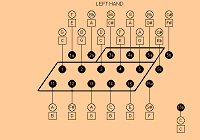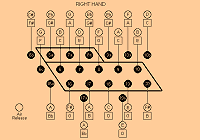Linked pages:
How to Play the Anglo - Part 1
by
John Kirkpatrick
From The Concertina Newsletter, Issue No 9, December 1972
First catch your Anglo. In case you don't know how to recognise the species, and as this series of articles is supposed to be starting from scratch, let's say a bit first about what it is.
The Anglo is a cross between the English (double action) concertina invented by Wheatstone and the German suck-blow (single action) system devised a few years earlier by Buschmann of Berlin and incorporated into his mouth organ and melodeon. Hence Anglo-German, or Anglo for short. The constant in and out movement of the bellows necessitates strict control of the instrument which is achieved by having a strap across the whole of the back of the hand, as opposed to the thumb strap and single finger support on the English. This means that all the fingers, and the thumbs if they've got prehensile tendencies, are available for playing. The other main difference in appearance is that in the playing position the keys on the Anglo are arranged in vertical rows, falling easily under the fingers, whereas the rows on the English are horizontal.
Now to the diagram, which is a plan of my model. (Crabb No.18264, bought new in December 1968). For those of you who like things that way I've also given the musical notation for the actual notes sounded by each button. If you can understand it you will see that the high notes are on the right hand side, low notes on the left. The middle of the three rows gives the diatonic scale of C major; the row below that the scale of G major; and the row furthest away from you is a haphazard collection of sharps and flats, along with some notes which occur on the other rows in the opposite direction of the bellows.
The area enclosed by the rectangle on each side is the layout on the small 20-key Anglo which you can get easily and cheaply at most music shops. When you first start playing it's best to ignore anything outside this basic area anyway, so these instruments are not bad to begin on if you can't get anything else. However that is all there is to say in their favour as they are little better than toys and their limitations will soon become apparent.
Something else which became apparent to even the most obtuse observer at my rather frantic workshop at the Long Eaton Convention is that the classification 'Anglo' covers such a variety of keys, pitches, and keyboard layouts that any attempt to write a comprehensive article is bound to be inadequate. Consequently your model is quite likely to be different from mine, especially in the arrangement of the accidental row, in which case you'll have to work out for yourself which notes are where.
If your box is in different keys, B-flat and F for example, then just pretend it's in C and G and hope for the best. This works OK until you start wondering exactly what notes you're playing, so here is a table designed to help you transpose what I say about C into the key of your own instrument.
|
C
|
Do | - first | - tonic |
|
D
|
Re | - second | - supertonic |
|
E
|
Me | - third | - mediant |
|
F
|
Fa | - fourth | - subdominant |
|
G
|
So | - fifth | - dominant |
|
A
|
La | - sixth | - submediant |
|
B
|
Ti | - seventh | - leading note |
For example, if you have a B-flat box and you want to find E-flat, with the aid of a few speedy calculations you can eventually reach the conclusion that E-flat, is the fourth, or subdominant, or Fa, in the scale of B-flat - According to the table the relative note In the C scale is F on the diagram and then onto your next note! If you work out every tune like this it may be some weeks before you get as far as the B music but it might help somebody, somewhere, sometime.
Whatever key your box is in, think of it in relative terms rather than in terms of specific notes. The table shows three different ways of describing the relative position of the notes of the scale and just use whichever you can cotton on to most easily. Then whenever you want to find a particular note or chord, work out its relation to the basic key of your box, find out which note or chord is in the same relative position on a C box, and look for it on the diagram.
To avoid constant repetition of the words "push" and
"pull" I'll use a square to represent "push",
a circle for "pull". So  means push button 6 to give C;
means push button 6 to give C;  means pull 6 to give B; and in the diagram button 7 gives E when
you push the bellows, D when you pull. I hope this isn't too confusing
and in the end it will save unnecessary verbiage.
means pull 6 to give B; and in the diagram button 7 gives E when
you push the bellows, D when you pull. I hope this isn't too confusing
and in the end it will save unnecessary verbiage.
Thus the scale of C over the middle two
octaves goes like this: C (or Do or Tonic etc)
C  ; ; |
D  ; ; |
E  ; ; |
F  ; ; |
G  ; ; |
A  ; ; |
B  ; ; |
C  ; ; |
D  ; ; |
E  ; ; |
F  ; ; |
G  ; ; |
A  ; ; |
B  ; ; |
C  |
And the scale of G has exactly the same sequence
of pushes and pulls
starting G  .
.
This system gives you the notes of the major chord when you push, while everything else is on the pull. Many potential Anglophiles give up at this stage, when they realise that each button plays a different note when you push the bellows from. when you pull. It does seem that some people take to the suck-blow system like a duck to water while others have a mental blockage which reduces them to a quivering mass every time they start heaving at the bellows. All the same don't give up too easily. One way round the problem is to try a melodeon first, as you can concentrate on hitting the right notes with one hand and waggling the bellows in the right direction with the other. Once you can manage that just imagine the Anglo is like the right hand end of a melodeon split in half, and away you go. Having graduated from a melodeon myself I can vouch for a fairly painless transition.
And with that I'll leave you to run up and down the scale a few times and then try some simple tunes, eg: Shepherds Hey, Bobby Shafto, In and Out the Windows, God save the Queen, The Dead March etc. In later articles I'll tackle fingering and chords among other things, so don't be impatient if you knew all this lot already. Meanwhile you could do worse than to listen to as much Anglo playing as possible - William Kimber (on EFDSS LP 1001), or in the flesh watch out for Kenneth Loveless, John Watcham (of Chingford Morris) Phil Ham (also morris but I don't know which), all of whom have been playing for quite a few years. Pete Bellamy sings with an Anglo, and the whole population of Hull plays the instrument too. Or as a last resort you can hear my own efforts on 'Morris On' (Island Records, HELP 5), and 'Jump at the Sun' (Trailer LER 2033). Till next month, Happy Squeezing!

